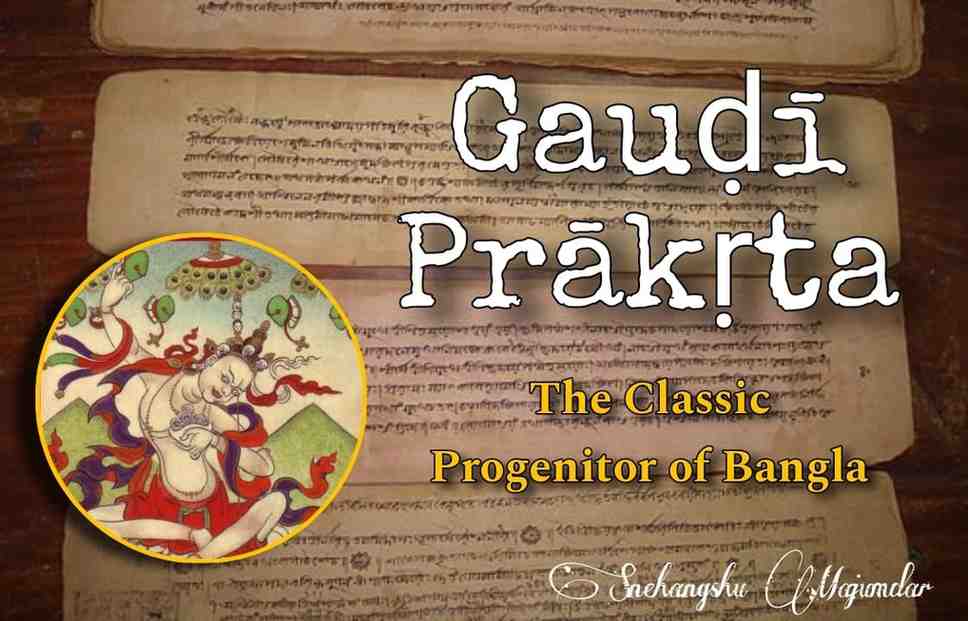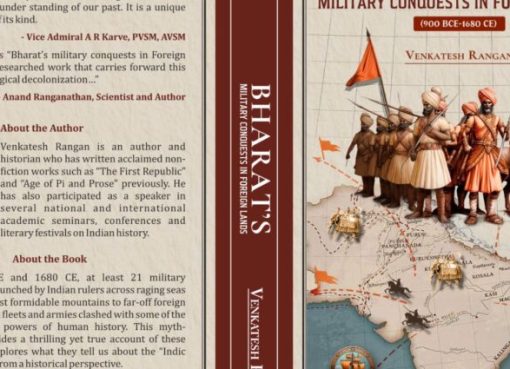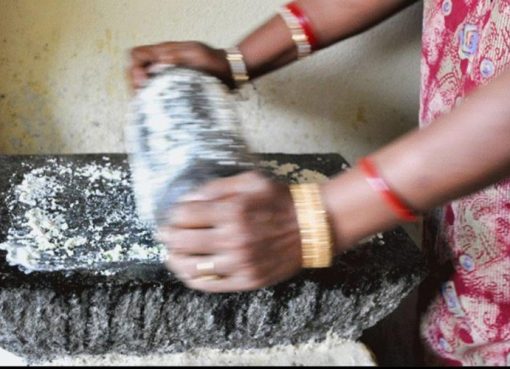Gaudi Prakrit (গৌড়ী প্রাকৃত/ Gauḍī Prākṛta) is the postulated Middle Indo-Aryan (MIA) Prakrit language used in ancient Gauḍa (6th-12th century). This language has been derived from ancient eastern Prācya Prākṛta and the historical ancestor of the Gauḍīya Bhāṣā and the Baṅgabhāṣā or modern Bangla language. The documentation of Gauḍī Prākṛta can be dated prior to the 7th century AD, when the proto-Bengali language, the parent of the modern Bengali language, began to develop.
A distinctive language, linguistic style, alphabet, etc., that developed amongst the Gaudas and frequently referred to in some of the early literary texts. Bäna in an introductory verse of the Harshacharita (1/7-8) speaks of the fondness for Väksharadambaraḥ amongst the people of Gauḍa (Gauḍeśa), i.e. display of sonorous words is said to be the characteristic of the Gauḍa people. Daṇḍin and Bhāmaha who flourished in the 7th/8th century A.D. speak of two styles, Dakshinātya and Paurastya. According to Daṇḍin, Paurastya is represented by the Gaudiya style “which favoured alliteration and harsh sound effects, recondite etymologizing phraseology and strength of ten resulting in bombast and affectation”.
Mention of Gaudi Prakrita in the Kavyadarsha of Dandin (7th Century AD) :
The 7th-century AD seminal work of Sanskrit literary criticism, ‘Kāvyādarśa’, written by Daṇḍin accords the Gauḍī Prākṛta a preeminent status as a literary lingua franca of India, extolled for its rarefied elegance and canonical significance.
शौरसेनी च गौड़ी च लाटी बान्यापि तादृशी ।
याति प्राकृतमित्येवं व्यवहारेषु संनिधिम् ॥ ३५ ॥
Śaurasenī Ca Gauḍī Ca Lāṭī Bānyāpi Tādṛśī |
Yāti Prākṛtam Ity Evaṃ Vyavahāreṣu Saṃnidhim || 35 ||
[Translation : The Shauraseni, Gaudi, and Lati languages exhibit a paradigmatic affinity, converging in their pragmatic application to precipitate a Prakrit nexus, thereby underscoring their proximal relationship.]
This venerable citation unequivocally establishes Gauḍī Prākṛta as the progenitor and antecedent of the Bengali language, thereby cementing its status as the ancestral lingua from which the latter’s distinctive phonological, morphological, and lexical features have evolved. This reference also confirms Gauḍī Prākṛta’s distinct form existed in the Gupta period, cementing its role in the classic evolution of the Bangla language.
Difference of Gaudi Prakrita with Magadhi Prakrita :
A notable characteristic of Magadhi Prakrit’s phonology is the replacement of Sanskrit’s vargiya ‘ज (j)’ with ‘य (y)’ and the replacement of other Prakrit’s ‘ज्ज (j)’ with ‘य्य(yy)’. For example, Sanskrit ‘জল/जल (jala)’ becomes ‘यल (yala)’ in Magadhi; Sanskrit ‘কার্য/कार्य (kārya)’ becomes ‘কজ্জ/कज्ज (kajja)’ in Gaudi Prakrit, but ‘कय्य (kayya)’ in Magadhi; Sanskrit ‘অদ্য/अद्य (adya)’ becomes ‘অজ্জ/अज्ज (ajja)’ in Gaudi Prakrit, but ‘अय्य (ayya)’ in Magadhi. In Bengali, we see ‘জল (jala)’, ‘কাজ (kāja)’, ‘আজ (āja)’, etc., which cannot come from Magadhi Prakrit.
In classical and medieval Bengali, we see ‘কৈল (kaila)’, ‘কএল (ka’ēla)’, ‘মৈল (maila)’, ‘মএল (ma’ēla)’, which come from Prakrit ‘ka’a < Sanskrit ‘kr̥ta’, ‘ma’a < Sanskrit ‘mr̥ta’, and ‘il’ added to the verb ‘gata’ with the meaning of ‘gone’. These do not come from Magadhi Prakrit’s ‘kaṛa’, ‘maṛa’, ‘gaṛa’. The words ‘kaila’ etc. are so common that they cannot be borrowed.
Just as in Magadhi Prakrit, the three Uṣma sounds Śa, Ṣa and Sa (श, ष, and स) are replaced with ‘श’ (Śa), similarly ‘र’ (ra) is replaced with ‘ल’ (la). This is stated in Hemchandra’s Prākṛta Vyākaraṇa Sūtra (8.4.288) as “रसो र्लशौ [raso rlaśau]”. However, no other regional language, including Bengali and its sister languages, exhibits both these changes simultaneously. Although Bengali has the ‘শ/श’ sound, it lacks the ‘ल’ sound (replacing ‘र’). The few instances of ‘र’ being replaced with ‘ल’ can be attributed to influence from other Prakrit languages, such as the Bengali word ‘হলুদ/हलुद’ (holud) coming from ‘হলদ্দী/हलद्दी’ (haladdi) in Prakrit, coming from ‘হরিদ্রা/हरिद्रा (haridrā) of Sanskrit. Therefore, solely based on the presence of the ‘श’ sound, it cannot be concluded that Bengali originated from Magadhi Prakrit.
The ‘শ/श’ sound in Bengali is not contemporaneous with the original Eastern Apabhramsha. If it were, we would expect to see ‘श’ in Bengali’s sister languages as well. Instead, we find ‘स’ (sa) in Odia and Bihari, and ‘ह’ (ha) in Assamese. Even in the western dialects of Bengali, the dental ‘Sa (স/स)’ sound is still prevalent. Outside of Bengali, languages like Hindi, Nepali, Gujarati, Sindhi, and Punjabi also have only the ‘स’ sound in place of ‘श’, ‘ष’, and ‘स’. This ‘स’ sound was also present in Shauraseni and Maharashtri Prakrit. The presence of ‘स’ in Ashoka’s eastern edicts and in Pali confirms its existence in ancient Eastern Prakrit. It’s worth noting that Ashoka’s eastern edicts have ‘ल’ but no ‘श’. We only find both ‘श’ and ‘ल’ in the Ramgarh stone inscription. Therefore, the ‘श’ sound in Bengali is a later development, just like the replacement of ‘श’, ‘ष’, and ‘स’ with ‘ह’ in the dialects of eastern Bengal and Assam, which is an even later sound change.
In the Gauḍī Prākṛta or classical Bengali, we see the ‘হ (ha)’ form in the first person singular of the verb in the perfect tense. This cannot come from Magadhi’s hakē, hagē saṯ ahakam aham, but it comes from Ashoka’s eastern edict “hakaṁ ahakam aham”. What has been said above proves that Bengali and its sister languages did not originate from Magadhi Prakrit but from its own progenitor the Gaudi Prakrita. Scholars like A.B. Keith also holds this view.
Distinctive Features of Gaudi Prakrita :
With the help of comparative linguistics, the distinctive features of the Gaudi Prakrita language can be described as follows:
– Like Paishachi Prakrita, ‘ṇ (ণ/ण)’ was used instead of ‘n (ন/न)’ sound.
– At the beginning of words, vargīẏa ‘b (ব)’ sound and antaḥstha ‘v (ৱ)’ sound became vargīẏa ‘b (ব)’ sound.
– Like Maharashtri Prakrita, ‘j (জ)’ was used instead of initial ‘y (য)’, and ‘jj (জ্জ)’ was used instead of non-initial ‘dya’, ‘rja’, ‘ryya’, etc.
– The ‘r’ sound remained mostly unchanged.
– Probably, like Maharashtri Prakrita, ‘sa’ was used instead of ‘śa’ and ‘ṣa’ sounds.
– We have mentioned earlier that the ‘ś’ sound in Bengali is a recent development in the language. In ancient Bengali, the Gaudi Prakrita language had distinct and clear pronunciation of ‘ś’, ‘ṣ’, and ‘s’ sounds.
If comparative linguistics can reconstruct the Indo-European proto-language, then it should also be possible to reconstruct this proto-Bangla language ‘Gaudi Prakrita’.
The Gauda Apabhramsha :
The next stage of Gaudi Prakrita is Gauḍa Apabhraṃśa. Vaiẏākaraṇa Mārkaṇḍēẏa, a Prakrita grammarian, mentions Gauḍa Apabhraṃśa as one of the 27 Apabhraṃśa languages. Some examples of Gauḍa Apabhraṃśa can be found in Kāhṇa’s and Saraha’s Dōhā-koṣa and in Prākṛta Piṅgala.
Characteristics of Gauda Apabhransa:
1. In general, the vibhakti (case ending) was dropped in the nominative and accusative cases.
2. In nominal sentences, the subject and predicate adjective sometimes took an “e (এ)” ending.
3. The relational words agreed with the relevant noun in gender, like an attributive adjective.
4. In sakarmaka (transitive) verbs, the past and future tenses agreed with the gender of the object.
5. In akarmaka (intransitive) verbs, the past and future tenses agreed with the gender of the subject.
Some examples of Gauda Apabhransa:
1. বুদ্ধ ঘোড়অ দেখই | “Bud’dha ghōṛa’a dēkha’i” (Buddha saw the horse).
2. এহু গচ্ছে বড্ডে | “Ēhu gacchē baḍḍē” (This tree is big).
3. রামকেরী বাড়ীত্ত বহুত্ত গচ্ছানি আচ্ছন্তি | “Rāmakērī bāṛītta bahutta gacchāni ācchanti” (There are many trees in Ram’s house).
4. মই তেন্তিলী খাইল্লী । মই দিব্বি পিরিচ্ছা “Ma’i tēntilī khā’illī” (I ate the tamarind). “Ma’i dibbi piricchā” (I will ask).
5. বহিনী ঘরে গইল্লী | “Bahinī gharē ga’illī” (The sister went home).
Bangla language originated from this Gauḍa Apabhraṃśa. That’s why Bangla language was once called Gauḍīẏa bhāṣā, the Gaudiya language.
The Language of Charyapada – Gauda Apabhramsha :
The Charyapada, a revered corpus of mystical songs, is redolent with the linguistic vestiges of Gauḍa Apabhraṃśa, a erstwhile language that once flourished in the eastern extremities of the Indian subcontinent. The Doha-kosha, a treasure trove of couplets penned by the venerable Kahna and Saraha, serves as a testament to the linguistic idiosyncrasies of this bygone era. The Prakrita Pingala, an ancient treatise on prosody, further corroborates the notion that Gauḍa Apabhraṃśa was the linguistic medium through which the Charyapada’s esoteric wisdom was conveyed.
The language of the Charyapada is characterized by a distinctive blend of simplicity and profundity, its Gauda Apabramsha patois imbuing the verses with an air of intimacy and immediacy. The poets’ deliberate eschewal of ornate Sanskritisms in favor of a more colloquial, vernacular idiom lends the songs an unmediated quality, as if the mystics’ innermost experiences are being directly communicated to the listener. Thus, the Gauda Apabramsha language of the Charyapada serves as a vital conduit for the transmission of the poets’ ecstatic visions and spiritual insights, its linguistic peculiarities and idiomatic expressions imbuing the songs with a unique cultural and historical resonance.
REFERENCES :
1. Kavyadarsa Of Dandin, by Tarkabagisa, Premchandra, 1863
2. Kavyadarsa Of Dandin, by S K Belvalkar,1924
3. Kavyadarsa Of Dandin 1938, by V P Rangacharya,1938
4. The People and Culture of Bengal, a Study in Origins, A. Chattopadhyay, 1960
5. Studies in the Geography of Ancient and Medieval India, by D.C. Sircar, 1971
6. Bangala Bhasha’r Itibritta, by Dr. Muhammad Shahidullah
[About the Author : As the visionary founder and independent researcher at Gaudiya Warriors, Sri Snehangshu Majumdar embarks on an odyssey of discovery, navigating the confluences of language, history, and heritage. With an insatiable curiosity and passion for the intricacies of human expression, he delves into the realms of linguistics, military history, and classical antiquity, unearthing hidden patterns and connections that illuminate the grand tapestry of human civilization.]







Comment here
You must be logged in to post a comment.